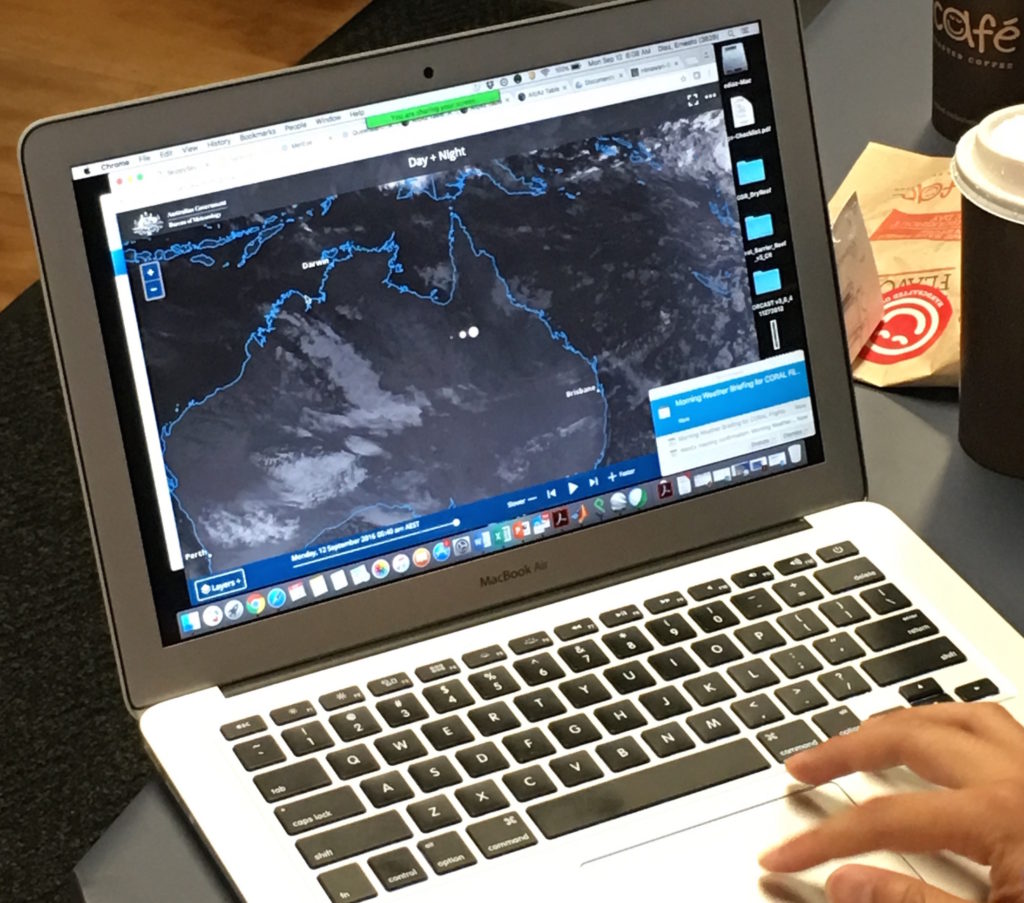
by Alan Buis / Cairns, North Queensland, Australia /
On a non-flight day this week, I had a chance to chat with some of the crew from NASA’s Jet Propulsion Laboratory who are here in Australia to support the Coral Reef Airborne Laboratory’s (CORAL) Great Barrier Reef deployment about their roles in the mission.
Ernesto Diaz is CORAL’s project system engineer and mission campaign manager. He joined JPL in 2010 and is currently in JPL’s imaging spectroscopy group, working on PRISM and other spectrometer instrument programs that are pathfinders to develop technology for a planned NASA satellite called the Hyperspectral Infrared Imager.
Among Diaz’s responsibilities is to assess the weather each day to determine if a flight will be attempted. The team’s routine includes daily 6 a.m. weather assessment briefings. Diaz bases his assessments and recommendations on data from the Australian Bureau of Meteorology.
“I’m not a meteorologist,” he said. “But I’ve come to understand weather patterns well. A key is assessing how weather patterns are going to evolve over the course of a typical CORAL flight over the Great Barrier Reef, which can run from three to six hours.”

Because PRISM is a passive imaging system, meaning that it records the amount of light energy reflected back to it from Earth’s surface, it requires a cloud-free view to the ground below. CORAL’s science requirements state that cloud cover over a target area must be less than 20 percent, including clouds both below and above the plane. Winds must also be light, because strong winds create chop on the sea surface that interferes with PRISM’s performance.
Diaz said PRISM has two flight opportunities each day: one in the morning and one in the afternoon. On days when the initial 6 a.m. forecast looks favorable, the team is given a go to turn the PRISM instrument on. A second weather go/no-go call is then made at 8 a.m. prior to a takeoff at 8:30 a.m. Morning opportunities are typically better for winds.
The CORAL Great Barrier Reef deployment requires collecting data from 10 regions over the reef, and the PRISM aircraft is limited to a total of 48 flight hours. Because weather and technical delays are unpredictable, the CORAL mission has allotted a full two months to collect the necessary data. “There’s no reason to rush and get bad data,” he said. “We want to get the best possible data on flight days. When we don’t fly, it’s an opportunity to do routine maintenance.”
Diaz says CORAL is his favorite project since he’s been involved with it since its inception and he designed all the flight lines for the campaign. Imaging spectrometers have taken him not only to the Pacific, but to Chile and India as well. On the team’s day off this week, he and his wife went to Kuranda Koala Gardens, about 45 minutes north of Cairns, and got to hold and pet a koala. “It’s a perk of the job,” he said.
Technician Scott Nolte built hardware for PRISM’s high-powered UNIX-based electronics subsystem, which has the highest signal-to-noise ratio performance of all of JPL’s imaging spectrometers.

Nolte has worked at JPL for 33 years, 15 of them in the lab’s imaging spectroscopy group. He said he’s seen a lot of growth.
“For the first seven or eight years I was in the group, we only had the Airborne Visible/Infrared Imaging Spectrometer (AVIRIS) Classic instrument. Now we have multiple hyperspectral imager programs.”
For Nolte, a typical day in the field with PRISM consists of cooling the instrument’s camera down and stabilizing its temperature two hours before takeoff, as well as any required troubleshooting as necessary.
Nolte’s work has taken him to places like Hawaii; Norway; Punta Arenas, Chile; St. Croix; and Marathon in the Florida Keys. This is his first visit to Australia. “PRISM gets some pretty sweet deployments,” he said.
Justin Haag is PRISM’s optical engineer. His job is to make sure the PRISM instrument is working and ready. The Illinois native and graduate of Northern Illinois University and UC San Diego joined JPL two years ago.

When I caught up with Haag, he, Diaz and Nolte were making hardware adjustments to part of PRISM’s field health assessment kit. Unlike calibration tests, which are performed on PRISM both before and after its mission campaigns, the field health assessment kit is used to periodically assess PRISM’s performance between flights. It consists of a sphere attached to PRISM’s external camera port on the exterior of the Gulfstream IV aircraft. Two different types of lamps are shined into the sphere, which bounces the light around the sphere’s white, coated interior to create a uniform light input for PRISM to measure.
A previous health assessment test last week had detected some light leaking into the sphere through exterior gaps in the kit fixture’s hardware. The team’s solution? They covered the gaps with black tape. Think of it as an adult version of the arts and crafts we all did in elementary school.
Not every problem requires a high-tech solution. Just a little old-fashioned ingenuity.
